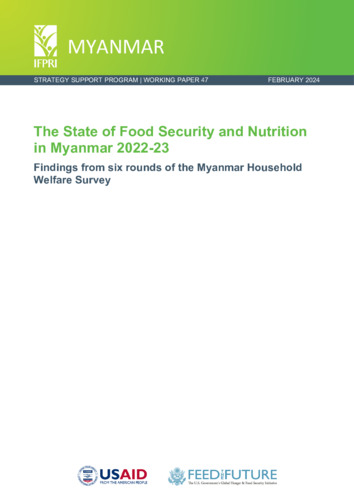The state of food security and Nutrition in Myanmar 2022-23: Findings from six rounds of the Myanmar Household Welfare Survey
Abstract
This working paper explores the state of food security and nutrition in Myanmar using 6 rounds of nationally representative household panel data collected from December 2021 to November 2023. Overall, the state of food security and nutrition has deteriorated in Myanmar in 2022-23. More than 3 percent of households were in moderate to severe hunger in September-November 2023. Hunger was highest in Chin (8.7 percent) and Tanintharyi (7.0 percent). Households with a low food consumption score increased from 9.4 percent in December 2021-February 2022 to 15.9 percent in October-December 2022 and remained high at 14.4 percent in September-November 2023. The shares in September-November 2023 were highest in Chin (38.2 percent), Kayah (22.4 percent), and Magway (20 percent). Inadequate diet diversity among adults rose from 20.6 percent to 30.9 percent over December 2021-February 2022 to October-December 2022, with an increase of 5.9 percentage points in the past one year. Women saw a faster decline in diet quality from December-February 2022 to September-November 2023 (12.1 percentage points increase in poor diet quality vs 8.4 percentage points for men). Decreases in diet quality among adults are driven by lower consumption of milk and dairy products as well as Vitamin A rich fruits, meat, fish, and eggs. 34.5 percent of all children aged 6-23 months and nearly a quarter (23.6 percent) of all children aged 6-59 months had inadequate diet quality in the latest round of survey. Regression analysis reveals low income and limited assets to be important risk factors for food security and adequate diet quality. Wage workers and low wage communities are found to be particularly vulnerable. Rising food prices, conflict and physical insecurity increase the likelihood of poor diet quality. Receiving remittances is a source of resilience; remittance-receiving households are less likely to experience hunger or poor dietary diversity at the household, adult, and child level. To avert a full-blown nutrition crisis in Myanmar, effective multisectoral steps are required to protect nutritionally vulnerable populations. Expanded implementation of nutrition- and gender sensitive social protection programs, including maternal and child cash transfers, particularly to vulnerable groups is called for. Further, given the importance of remittances as an effective coping mechanism, supporting migration and the flow of remittances would help to improve the welfare of the Myanmar population.

